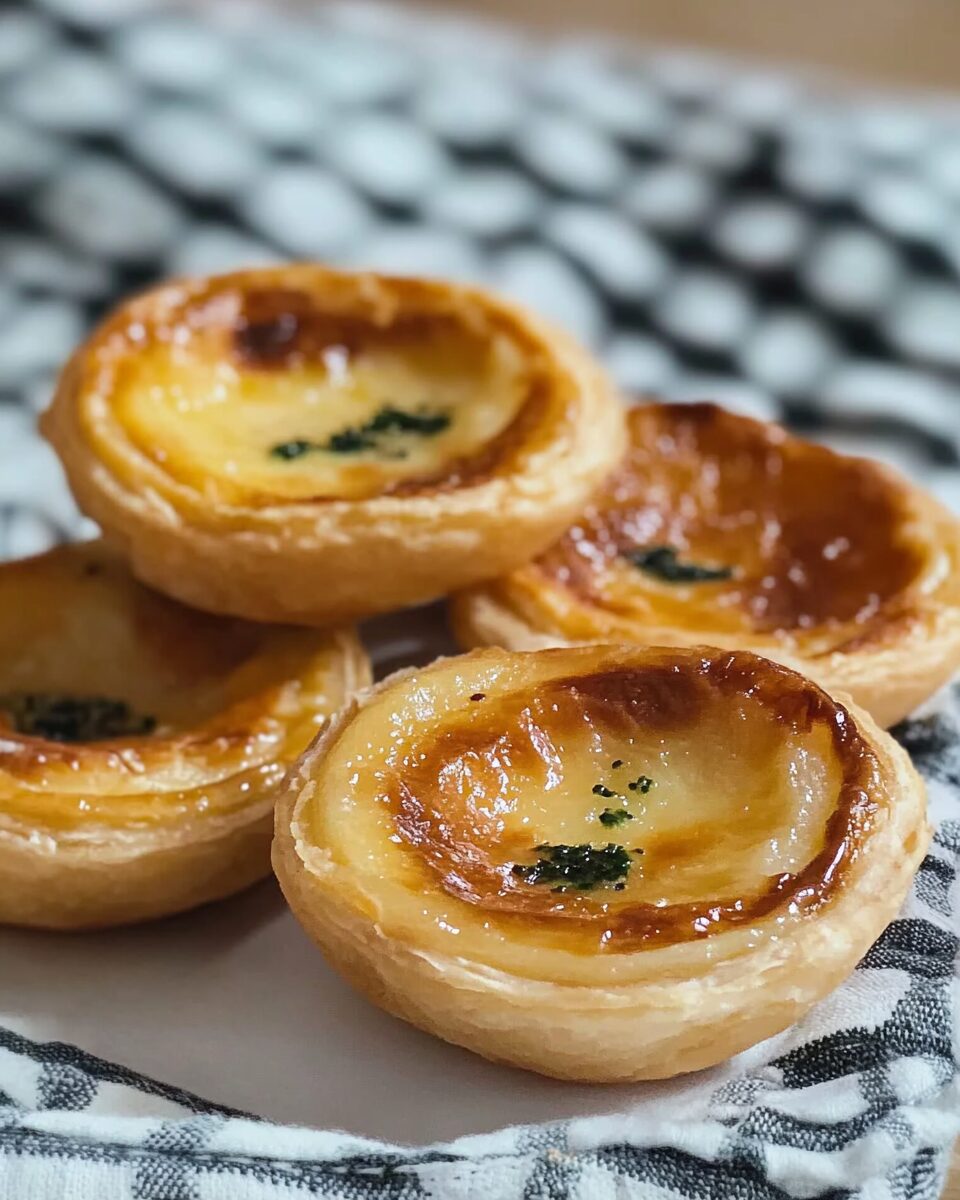Pasteis de nata are delightful Portuguese custard tarts featuring an exceptionally flaky crust, a caramelized top, and a smooth, rich custard filling. They are a staple in Lisbon’s cafes, most famously at Pasteis de Belem, where they’ve been crafted for nearly 200 years. While the original recipe remains a secret, this version aims to replicate the beloved treat.
Full Recipe:
Ingredients
For the pastry dough:
For the custard filling:
To finish:
Directions
Preparing the dough:
In a medium bowl or stand mixer, combine 1 cup of flour, salt, and water. Knead until the dough is soft and tacky but not sticky; add 2 more tablespoons of flour if too sticky. Cover and let rest for 15 minutes.
On a well-floured surface, roll out the dough into a 12-inch square. Spread 1/3 of the butter over the left 2/3 of the dough, leaving a 1-inch border. Fold the right unbuttered third over the middle, then the left third over that, like an envelope. Rotate 90 degrees and repeat the buttering and folding process twice more. After the final fold, roll the dough into a 14-inch-long rectangle, spread the remaining butter over the entire surface, and roll it up tightly from the edge closest to you. Wrap in plastic and refrigerate for 30 minutes.
Preparing the custard:
In a saucepan, combine sugar, water, cinnamon stick, and lemon peel. Bring to a simmer without stirring until it reaches 225°F. Set aside.
In another saucepan, whisk together flour and 2 tablespoons of milk to form a paste. Gradually add the remaining milk, whisking continuously. Cook over low heat until the mixture thickens. In a separate bowl, whisk the egg yolks. Gradually add some of the hot milk mixture to the yolks, whisking to temper, then combine back into the saucepan. Add the sugar syrup (discarding the cinnamon stick and lemon peel) and vanilla paste. Cook over low heat, stirring continuously, until the custard thickens enough to coat the back of a spoon.
Assembling and baking the tarts:
Retrieve the dough from the refrigerator and cut into 2/3-inch sections (1-inch if using a muffin tin). Place each piece, cut side up, into lightly greased molds. Using your thumb, press the dough down in the center and spread it along the sides to form a thin, even layer without holes.
Fill each pastry shell 3/4 full with the cooled custard. Bake in a preheated oven at 550°F for approximately 8 minutes. If the pastry cooks faster than the custard caramelizes, finish with a few minutes under the broiler. Keep a close eye to prevent burning.
Allow the tarts to cool for a few minutes before removing them from the molds. Serve warm, optionally dusted with powdered sugar and cinnamon.
Nutrients
Per tart (approximate):
-
Calories: 210 kcal
-
Carbohydrates: 24g
-
Protein: 3g
-
Fat: 11g
-
Saturated Fat: 6g
-
Cholesterol: 80mg
-
Sodium: 50mg
-
Sugar: 12g
Historical Origins
The origins of pastéis de nata date back to the 18th century at the Jerónimos Monastery in Lisbon’s Belém district. Monks and nuns used large quantities of egg whites for starching clothes, leaving an abundance of egg yolks. To prevent waste, they created various confections, including these custard tarts. Following the dissolution of monasteries in the 19th century, the secret recipe was sold to a sugar refinery, whose owners opened the Fábrica de Pastéis de Belém in 1837. This establishment continues to produce the original pastries, with the recipe remaining a closely guarded secret.
Cultural Significance
In Portugal, enjoying a pastel de nata is more than indulging in a sweet treat; it’s a cherished ritual. Locals often pair the tart with a strong espresso, known as “bica,” savoring the moment in neighborhood cafés. This practice embodies the Portuguese appreciation for simple pleasures and community engagement. The pastry’s significance was further cemented in 2011 when it was voted one of Portugal’s Seven Wonders of Gastronomy, highlighting its esteemed place in the nation’s culinary landscape.
Global Popularity and Variations
The allure of pastéis de nata has transcended Portugal’s borders, gaining popularity in regions such as Western Europe, Asia, and former Portuguese colonies like Brazil and Macau. In Macau, a distinctive variant emerged in the late 1980s, characterized by a caramelized top and a slightly different filling, reflecting local tastes. This adaptation has influenced the proliferation of similar pastries across Asia, with global chains incorporating them into their offerings.
Crafting the Perfect Pastel de Nata
Creating an authentic pastel de nata is an art that demands precision and dedication. The process begins with preparing a laminated dough, akin to puff pastry, which is meticulously rolled and folded to achieve its signature flakiness. The custard filling combines egg yolks, sugar, milk, and occasionally cream, cooked to a smooth consistency. Once assembled, the tarts are baked at high temperatures until the custard surface caramelizes, resulting in characteristic dark spots. The balance between the crisp pastry and the creamy filling is essential to the pastry’s appeal.
Experiencing Pastéis de Nata in Portugal
For an authentic experience, visiting the Fábrica de Pastéis de Belém offers a taste of the original recipe in a historic setting. However, numerous other establishments throughout Lisbon and Portugal serve exceptional versions of the pastry. Pastelaria Aloma in Lisbon’s Campo de Ourique neighborhood has received accolades for its tarts, celebrated for their balanced flavor and texture. Exploring various pastelarias allows visitors to appreciate the subtle regional differences and personal touches each baker brings to this beloved treat.
Modern Innovations and Marketing
While the traditional pastel de nata remains a culinary icon, contemporary chefs and entrepreneurs have introduced innovative variations to cater to evolving tastes. In Japan, flavors such as matcha green tea and passion fruit have been incorporated, while in Paris, versions featuring Brie, Camembert, and blue cheese have emerged. These adaptations demonstrate the pastry’s versatility and global appeal. Despite these innovations, purists often favor the classic recipe, appreciating its historical roots and time-honored preparation methods.
Conclusion
Pastéis de nata embody the rich tapestry of Portuguese history, culture, and culinary artistry. From their humble monastic origins to their status as a global delicacy, these custard tarts have stood the test of time, delighting generations with their perfect harmony of flaky pastry and creamy filling.






